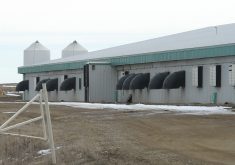Canaryseed producers who are looking for safe, dependable weed control options should stick with tried and true products, says Agriculture Canada weed researcher Bill May.
For example, he said Avadex is still the canaryseed producer’s best friend when controlling wild oats.
Applying granular Avadex in the fall provides good, although not complete, control of wild oats, he added.
As well, using Avadex instead of a Group 1 and 2 herbicides helps avoid herbicide resistant wild oat populations.
“I know it’s not 100 percent control … but it’s not a Group 1 or Group 2 product and we’re all facing problems related to herbicide tolerant wild oats,” he said.
Read Also

Activist urges new way to measure profitability
Organic activist praises Mark Carney for spearheading the Task Force on Climate-related Financial Disclosures.
“We want to be using as many groups and combinations of herbicides as we can to slow down herbicide tolerance, and when you’re growing canaryseed, this is an opportunity to do that because Avadex is probably one of the better products that we have outside of our Group 1 and 2 herbicides.”
Post-emergent Avenge is another wild oat option, but producers should be careful because the window for application is narrow and efficacy is reduced if the chemical is applied in hot, humid conditions.
For best results, Avenge should be applied in cool, dry conditions.
“Avenge is fairly potent stuff so that’s why I prefer Avadex,” May said.
“I really don’t like tank mixing Avenge with anything, even though it’s rated to be tank mixed with MCPA.”
Producers have tried Puma Super for grassy weed control, but it is not registered for canaryseed because the potential for crop damage is significant, May said.
It might be possible to limit crop damage by tweaking tank mixes that contain Puma, but he said as a rule, the safer Puma is made, the less effective wild oat control becomes.
No products are registered for controlling green foxtail in canaryseed, but producers have more options with broadleaf weeds, including Curtail M, Trophy, Prestige and Buctril M.
As well, growers can use dicamba products mixed with MCPA amine or dicamba mixed with MCPA and mecaprop.
May said he has had limited experience with dicamba, but producers who have used dicamba mixes report good results.
Tank mixes that include 2,4-D are not recommended, nor are Refine Extra or products that contain florasulam, such as Frontline.
“We don’t want anything with a 2,4-D mix and we don’t want anything that has florasulam in it,” May said.
“It’s not that you’re going to see a yield impact with (florasulam), but you could very easily see a two to three week delay in maturity, and that’s not something that you want too often.”
Refine Extra, a Group 2 herbicide, should be avoided.
The product was recommended at one time for canaryseed but the yield impact was too great.
“You won’t see any damage (with Refine) until you go to combine it, and then you’ll notice the difference,” May said.
“If you spray it on your fields, you will reduce your yields.”
He said limited Avadex supplies have forced some canaryseed producers to use other products for wild oat control, but he advised them to stick with Avadex, even if it means looking farther afield for supplies.
“If you can plan ahead for using Avadex, you’re way ahead.”















